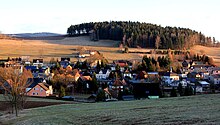Langenberg (Raschau-Markersbach)
Langenberg is a district of the municipality of Raschau-Markersbach in the Erzgebirgskreis , Saxony , in which about 600 people live.
geography
location
Langenberg is north of Raschau am Schwarzbach below the Emmler . State road 269 leads through the locality .
Neighboring places
| Waschleithe | Schwarzbach | |
| Wildenau |

|
|
| Quick look | Mittweida |
history
Langenberg is a relatively young village for the Ore Mountains. The starting point for the development of the place was the Förstelhammer north of Raschau , which, together with other hammer mills in the immediate vicinity of Raschau, was an indication of the rich iron stone deposits in the area. From the beginning of the 16th century at the latest, extensive mining was carried out on the Emmler and Graul . In 1534, the last abbot of Grünhain, Johannes Göpfert, issued a comprehensive mountain order. Eisenstein from the pits at Emmler, Hutstein and Langenberg was melted at the hammer mills in Mittweida and Pöhlwassertal , according to the official inheritance book for the Crottendorf office drawn up in 1559 . The attempt to operate the first blast furnace in the Western Ore Mountains here in 1580 failed, so that it was relocated to Rittersgrün in 1584 . In addition to his Förstelhammer, on the border between the Crottendorf Office and the Grünhain Office , the wealthy Hammerherr Nikolaus Klinger acquired a piece of land on the left side of the Schwarzbach from Raschau farmers on December 18, 1588. According to the chronicler Christian Lehmann , there was only a "colliery house" there. In 1614 the property passed to Klinger's son-in-law Rudolph von Schmertzing . On March 12, 1619, in an electoral privilege, he was given two wooded areas called "wood spikes" and the lower jurisdiction over all his properties, as well as the authorization to build twelve houses for the hammer smiths and miners who were employed in his hammer mill . These formed the origin of the parcel village of Langenberg, which subsequently developed only sparsely.
The residents went to worship in Raschau, where the place name Langenberg appears for the first time in 1620 in the church bills that have been preserved. The name of the village is evidently derived from that long and above all steep mountain that had to be conquered on the way to Raschau then as now. Over time, Langenberg developed as an independent place before it lost its independence in 1924 and was incorporated into Raschau. Mines such as the Asser tribe, God's destiny, St. Katharina and the Langenberg lime works to the southwest were of particular importance .
The former manor Förstel belongs to the Dr. Willmar Schwabe's non-profit Heimstättenbetriebsgesellschaft mbH .
literature
- Langenberg . In: August Schumann : Complete State, Post and Newspaper Lexicon of Saxony. 5th volume. Schumann, Zwickau 1818, p. 295.
- Siegfried Hübschmann: Raschau. About the becoming and growing of a church. Published by the council of the municipality on the occasion of the 750th anniversary, Raschau 1990.
- Siegfried Hübschmann: The Förstel in Langenberg. A historical foray. Published by the Dr. Willmar Schwabeschen Gemeinnützigen Heimstättenbetriebsgesellschaft mbH, Langenberg-Raschau, Heidler & Fahle Verlag, Scheibenberg 2002, ISBN 3-933625-27-0 .
- Karsten Richter: 425 years of Langenberg? About the beginnings of a miners' settlement in the Ore Mountains. Robin Hermann Verlag, Chemnitz 2013, ISBN 978-3-940860-10-1 .
Web links
- Langenberg in the Digital Historical Directory of Saxony
Coordinates: 50 ° 33 ' N , 12 ° 50' E

